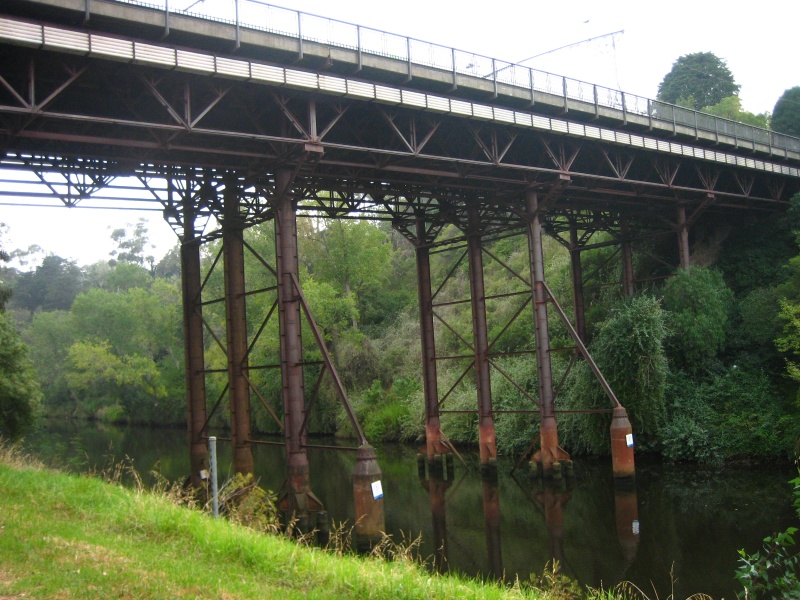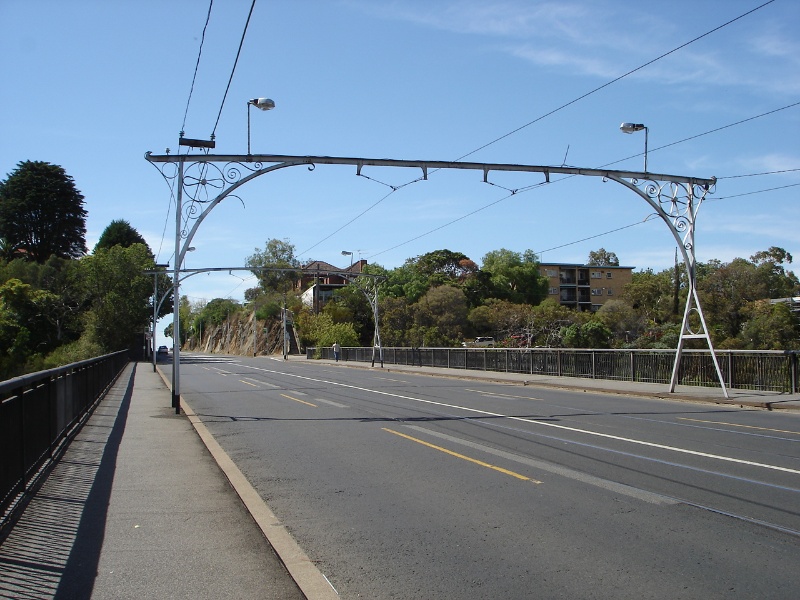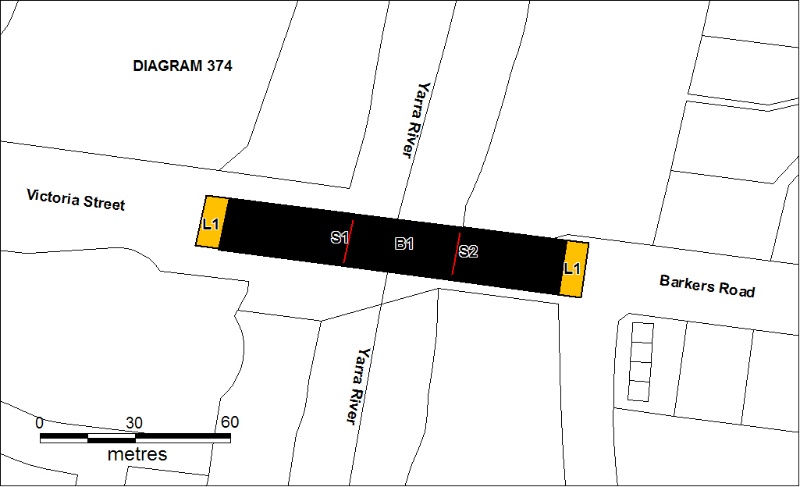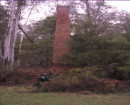VICTORIA BRIDGE
VICTORIA STREET RICHMOND AND BARKERS ROAD KEW, YARRA CITY, BOROONDARA CITY
-
Add to tour
You must log in to do that.
-
Share
-
Shortlist place
You must log in to do that.
- Download report








Statement of Significance
What is significant?
Victoria Bridge is a riveted and welded steel Warren truss bridge over the Yarra River completed in 1884 to a design by Fraser & Chase following a controversial design competition held in 1880. Funds for the bridge's construction were provided by the councils of Collingwood, Hawthorn, Kew and Richmond. The contract was awarded to Mr P. Platt. Charles Rowand was officially appointed Supervising Engineer in 1883. The winning design was based on the theoretical work of William Charles Kernot (1845-1909) who campaigned for economy in public works design and the application of scientific principles in engineering. Fraser & Chase, students of Kernot at the University of Melbourne and junior engineers in the Railway Construction Board and the Public Works Department, were criticised as not having sufficient experience to carry out the design which as a consequence was subject to intense scrutiny by more "practical" engineers. The design and materials reflected Kernot's concerns about economy and cost effectiveness. The utilitarian engineering evident in bridges on this part of the Yarra contrasts with the aesthetic design of bridges along the Yarra closer to the city.
The bridge was widened in 1890 by the addition of a third line of truss on new piers on the up stream side to carry horse trams. Work commenced in 1914 to convert the horse tramway to an electric tramway by the Prahran & Malvern Tramways Trust, part of the Trust's extension of its tramway into the eastern suburbs between 1913-18. In 1915 the bridge was further strengthened to accommodate the extra weight of electric trams and widened by the addition of two six feet cantilever footpaths. During this period the Prahran & Malvern Tramways Trust erected two ornamental gantries over the roadway to support overhead wires for the electric tramway.
Further widening and reconditioning of the bridge took place in 1933, including the addition of four new welded trusses, two intermediate and two on the outside. The latter were supported on new cantilevered truss cross beams attached to the top of the piers.
Victoria Bridge has seven lines of simply supported deck type Warren truss spans with upper sub-system bracing. The two original spans and third additional 1890 span are of riveted and bolted construction, between these and on the outside of the riveted spans are four welded steel trusses which match the earlier trusses. The deck is reinforced concrete on RSJ cross girders added in 1933. There are four piers comprising three riveted steel cylinders and a downstream angled brace on its own dwarf pier.
Each overhead tram gantry comprises A-framed steel uprights on either side of the road and a lightly curved main cross member of steel T section. The internal corners are decorated with curved steel strap to form spandrels which are in filled with decorative circles and curlicues. The decorative acroterion of steel strap originally at the centre point of the cross member has been lost. Electric lights have been attached to the gantries.
How is it significant?
Victoria Bridge is of historical, scientific (technical) and aesthetic significance to the State of Victoria.
Why is it significant?
Victoria Bridge is of historical significance as an important link in Melbourne's transport routes, its construction making Victoria Street/Barkers Road one of the principal east west routes in Melbourne. The bridge is of historical significance as a rare example of a joint facility initiated by four councils and reflects the importance of the bridge in facilitating travel and commerce between the industrial inner suburbs and the more affluent eastern suburbs. The utilitarian design and use of materials reflects budgetary constraints and the involvement of diverse councils.
Victoria Bridge is of historical significance for its association with the early history of the tramway system in Melbourne. The 1890 and 1915 modifications of the bridge and the ornamental overhead tramway gantries reflect the development of the tramway system. The gantries are of historical significance for their association with the formative decades of electric tramway development in Melbourne. They have an association with the Prahran & Malvern Tramways Trust, which grew to be the largest of such municipal trusts in Melbourne initially comprising Prahran and Malvern councils and later enlarged to include St Kilda, Caulfield, Kew and Hawthorn before its absorption by the Melbourne and Metropolitan Tramway Board in 1920.
Victoria Bridge is of scientific (technical) significance as one of a small group of riveted truss bridges in Victoria and the first to overtly apply engineering theory to truss design. Its design has associations with the contemporary debate on the relative values of theoretical and practical engineering and reflects developments in the engineering discipline.
The ornamental tramway overhead gantries are of aesthetic significance for their sophisticated early 20th century ornamental design, now relatively rare. As street furniture they demonstrate the high standard of infrastructure adopted by the Prahran & Malvern Tramways Trust.
-
-
VICTORIA BRIDGE - History
What is significant?
The two Ornamental Tramway Overhead Gantries were erected in 1916 on Victoria Street Bridge for the Prahran & Malvern Tramways Trust to support overhead wires for its electric tramway. The gantries closely resemble the structures on the Hawthorn Bridge (VHR H0050) and on the Wallen Road Bridge (VHR ProvH) which were erected in the same period.
The Prahran and Malvern Tramways Trust was established in 1910 when the Prahran and Malvern councils applied to construct an electric tramway. In 1911 it also included St Kilda and Caulfield councils and in 1915 enlarged to include Kew and Hawthorn. It grew to be the largest electric system in Melbourne extending to St Kilda, Caulfield, Glenhuntly, Hawthorn, Kew, Camberwell and Mont Albert. It was absorbed into the Melbourne and Metropolitan Tramway Board in 1920. The gantries were built as part of the extension of the tramway into the eastern suburbs between 1913-18.
Each gantry comprises A-framed steel uprights on either side of the road and a lightly curved main cross member of steel T section. The internal corners are decorated with curved steel strap to form spandrels which are in filled with decorative circles and curlicues. The decorative acroterion of steel strap at the centre point of the cross member has been lost. Electric lights have been attached to the gantry.
How is it significant?
The Ornamental Tramway Overhead Gantries on Victoria Bridge are of historical and aesthetic significance to the State of Victoria.
The Ornamental Tramway Overhead Gantries on Victoria Bridge are of historical significance for their association with the formative decades of electric tramway development in Melbourne. The gantries reflect the aspirations of the Prahran & Malvern Tramways Trust. The Trust was one of the most significant and successful of all the municipal undertakings and its services were partly responsible for the residential expansion of the eastern suburbs.
The Ornamental Tramway Overhead Gantries on Victoria Bridge are of aesthetic significance for their sophisticated early 20th century ornamental design, now relatively rare. As street furniture they demonstrate the high standard of infrastructure adopted by the Prahran & Malvern Tramways Trust.
Extent
Draft only - not yet approved by the Heritage Council
All the structures marked B1 and B2 on Diagram held by the Executive Director.
Permit exemptions
Draft only - not yet approved by the Heritage Council
Alterations and replacement of wiring provided no permanent alterations are made to the gantries.
Draft only - not yet approved by the Heritage Council
What is significant?
The Ornamental Tramway Overhead Gantry was erected in 1916 on Wallen Road Bridge for the Hawthorn Tramways Trust to carry overhead wires for the electric tramway. The gantry was manufactured by the firm H. Wallace and Son, engineers, blacksmiths and government contractors. The gantry closely resembles the structures on the Hawthorn Bridge (VHR H0050) and the Victoria Street Bridge (VHR ProvH) which were erected in the same period.
The gantry comprises A-framed steel uprights on either side of the road and a lightly curved main cross member of steel T section. The internal corners are decorated with curved steel strap to form spandrels which are in filled with decorative circles. The centre point of the cross member is decorated with an acroterion of steel strap in similar style. Small cantilevers on the outside carrying power lines are braced with a triangular steel web pierced with circular holes. Electric lights have been attached to the gantry.
The Hawthorn Tramways Trust was established on 14 June 1914 and comprised the councils of Melbourne, Richmond, Hawthorn and Camberwell. The Hawthorn Tramways Trust electric line to Burwood was opened on 6 April 1916 from Wallen Road and Power Street Hawthorn to Princes Bridge and only about a month before the line was opened the ornamental tram gantries were constructed on Wallen Road Bridge and Hawthorn Bridge. During 1916 the Trust opened numerous extensions of the line to Camberwell and Wattle Park. The Trust was absorbed into the Melbourne and Metropolitan Tramway Board in 1920.
How is it significant?
The Ornamental Tramway Overhead Gantry on Wallen Road Bridge is of historical and aesthetic significance to the State of Victoria.
The Ornamental Tramway Overhead Gantry on Wallen Road Bridge is of historical significance for its association with the formative decades of electric tramway development in Melbourne. The gantry reflects the aspirations of the Hawthorn Tramways Trust. The Trust was a significant municipal undertaking and its services were partly responsible for the residential expansion of the eastern suburbs.
The Ornamental Tramway Overhead Gantry on Wallen Road Bridge is of aesthetic significance for its sophisticated early 20th century ornamental design, now relatively rare. As street furniture it demonstrates the high standard of infrastructure adopted by the Hawthorn Tramways Trust.
Permit exemptions
Draft only - not yet approved by the Heritage Council
Alterations and replacement of wiring provided no permanent alterations are made to the gantries.
Victoria Street Bridge
Draft only - not yet approved by the Heritage Council
What is significant?
The Victoria Street Bridge is a riveted and welded steel Warren truss bridge over the Yarra River completed in 1884 to a design by Fraser & Chase following a controversial design competition held in 1880. Funds for the bridge's construction were provided by the councils of Collingwood, Hawthorn, Kew and Richmond. The winning design was based on the theoretical work of William Charles Kernot (1845-1909) in determining the truss geometry and optimum span to depth ratio. Kernot of the University of Melbourne campaigned for economy in public works design and the application of scientific principles in engineering. Fraser & Chase, students of Kernot and junior engineers in the Railway Construction Board and the Public Works Department, were criticised as not having sufficient experience to carry out the design which as a consequence was subject to intense scrutiny by more "practical" engineers.
The bridge was widened in 1890 by the addition of a third line of truss on new piers on the up stream side to carry horse trams with two footways. Work commenced in 1914 to convert the horse tramway to an electric tramway by the Prahran & Malvern Tramways Trust, part of the Trust's extension of its tramway into the eastern suburbs between 1913-18. In 1915 the bridge was further strengthened to accommodate the extra weight of electric trams and widened by the addition of two six feet cantilever footpaths. During this period the Prahran & Malvern Tramways Trust erected two ornamental tramway overhead gantries over the roadway to support overhead wires for the electric tramway.
Further widening and reconditioning of the bridge took place in 1933, including the addition of four new welded trusses, two intermediate and two on the outside. The latter were supported on new cantilevered truss cross beams attached to the top of the piers.
Victoria Bridge has seven lines of simply supported deck type Warren truss spans with upper sub-system bracing. The two original spans and third additional 1890 span are of riveted and bolted construction, between these and on the outside of the riveted spans are four welded steel trusses which match the earlier trusses. The deck is reinforced concrete on RSJ cross girders added in 1933. There are four piers comprising three riveted steel cylinders and a downstream angled brace on its own dwarf pier.
Each overhead tram gantry comprises A-framed steel uprights on either side of the road and a lightly curved main cross member of steel T section. The internal corners are decorated with curved steel strap to form spandrels which are in filled with decorative circles and curlicues. The decorative acroterion of steel strap at the centre point of the cross member has been lost. Electric lights have been attached to the gantries.
How is it significant?
Victoria Street Bridge is of historical, scientific (technical) and aesthetic significance to the State of Victoria.
Why is it significant?
Victoria Street Bridge is of historical significance as an important link in Melbourne's transport routes, its construction making Victoria Street/Barkers Road one of the principal east west routes in Melbourne. The bridge is of historical significance as a rare example of a joint facility initiated by four councils and reflects the importance of the bridge in facilitating travel and commerce between the industrial inner suburbs and the more affluent eastern suburbs. The utilitarian design and use of materials reflects budgetary constraints and the involvement of diverse councils.
Victoria Street Bridge is of historical significance for its association with the early history of the tramway system in Melbourne. The 1890 and 1915 modifications of the bridge and the ornamental overhead tramway gantries reflect the development of the tramway system. The gantries are of historical significance for their association with the formative decades of electric tramway development in Melbourne. They have an association with the Prahran & Malvern Tramways Trust, which grew to be the largest of such municipal trusts in Melbourne extending to St Kilda, Caulfield, Glenhuntly, Hawthorn, Kew, Camberwell and Mont Albert before its absorption by the Melbourne and Metropolitan Tramway Board in 1920.
Victoria Street Bridge is of scientific (technical) significance as one of a small group of riveted truss bridges in Victoria and the first to overtly apply engineering theory to truss design. Its design has associations with the contemporary debate on the relative values of theoretical and practical engineering and reflects developments in the engineering discipline.
The ornamental tramway overhead gantries are of aesthetic significance for their sophisticated early 20th century ornamental design, now relatively rare. As street furniture they demonstrate the high standard of infrastructure adopted by the Prahran & Malvern Tramways Trust.
VICTORIA BRIDGE - Plaque Citation
Victoria Bridge, completed in 1884, became one of the main transport links between inner and eastern Melbourne. The 1916 overhead tram gantries reflect the formative decades of electric tramway development in Melbourne.
VICTORIA BRIDGE - Permit Exemptions
General Exemptions:General exemptions apply to all places and objects included in the Victorian Heritage Register (VHR). General exemptions have been designed to allow everyday activities, maintenance and changes to your property, which don’t harm its cultural heritage significance, to proceed without the need to obtain approvals under the Heritage Act 2017.Places of worship: In some circumstances, you can alter a place of worship to accommodate religious practices without a permit, but you must notify the Executive Director of Heritage Victoria before you start the works or activities at least 20 business days before the works or activities are to commence.Subdivision/consolidation: Permit exemptions exist for some subdivisions and consolidations. If the subdivision or consolidation is in accordance with a planning permit granted under Part 4 of the Planning and Environment Act 1987 and the application for the planning permit was referred to the Executive Director of Heritage Victoria as a determining referral authority, a permit is not required.Specific exemptions may also apply to your registered place or object. If applicable, these are listed below. Specific exemptions are tailored to the conservation and management needs of an individual registered place or object and set out works and activities that are exempt from the requirements of a permit. Specific exemptions prevail if they conflict with general exemptions. Find out more about heritage permit exemptions here.Specific Exemptions:General Conditions: 1. All exempted alterations are to be planned and carried out in a manner which prevents damage to the fabric of the registered place or object. General Conditions: 2. Should it become apparent during further inspection or the carrying out of works that original or previously hidden or inaccessible details of the place or object are revealed which relate to the significance of the place or object, then the exemption covering such works shall cease and Heritage Victoria shall be notified as soon as possible. Note: All archaeological places have the potential to contain significant sub-surface artefacts and other remains. In most cases it will be necessary to obtain approval from the Executive Director, Heritage Victoria before the undertaking any works that have a significant sub-surface component. General Conditions: 3. If there is a conservation policy and plan endorsed by the Executive Director, all works shall be in accordance with it. Note: The existence of a Conservation Management Plan or a Heritage Action Plan endorsed by the Executive Director, Heritage Victoria provides guidance for the management of the heritage values associated with the site. It may not be necessary to obtain a heritage permit for certain works specified in the management plan. General Conditions: 4. Nothing in this determination prevents the Executive Director from amending or rescinding all or any of the permit exemptions. General Conditions: 5. Nothing in this determination exempts owners or their agents from the responsibility to seek relevant planning or building permits from the responsible authorities where applicable. Regular Site Maintenance : The following site maintenance works are permit exempt under section 66 of the Heritage Act 1995: a) regular site maintenance provided the works do not involve the removal or destruction of any significant above-ground features or sub-surface archaeological artefacts or deposits; b) the maintenance of an item to retain its conditions or operation without the removal of or damage to the existing fabric or the introduction of new materials; c) cleaning including the removal of surface deposits, organic growths, or graffiti by the use of low pressure water and natural detergents and mild brushing and scrubbing; d) repairs, conservation and maintenance to plaques, memorials, roads and paths, fences and gates and drainage and irrigation. e) the replacement of existing services such as cabling, plumbing, wiring and fire services that uses existing routes, conduits or voids, and does not involve damage to or the removal of significant fabric. Note: Surface patina which has developed on the fabric may be an important part of the item's significance and if so needs to be preserved during maintenance and cleaning. Note: Any new materials used for repair must not exacerbate the decay of existing fabric due to chemical incompatibility, obscure existing fabric or limit access to existing fabric for future maintenance. Repair must maximise protection and retention of fabric and include the conservation of existing details or elements. Public Safety and Security : The following public safety and security activities are permit exempt under section 66 of the Heritage Act 1995, a) public safety and security activities provided the works do not involve the removal or destruction of any significant above-ground structures or sub-surface archaeological artefacts or deposits; b) the erection of temporary security fencing, scaffolding, hoardings or surveillance systems to prevent unauthorised access or secure public safety which will not adversely affect significant fabric of the place including archaeological features; c) development including emergency stabilisation necessary to secure safety where a site feature has been irreparably damaged or destabilised and represents a safety risk to its users or the public. Note: Urgent or emergency site works are to be undertaken by an appropriately qualified specialist such as a structural engineer, or other heritage professional. Signage and Site Interpretation : The following Signage and Site Interpretation activities are permit exempt under section 66 of the Heritage Act 1995, a) signage and site interpretation activities provided the works do not involve the removal or destruction of any significant above-ground structures or sub-surface archaeological artefacts or deposits; b) the erection of non-illuminated signage for the purpose of ensuring public safety or to assist in the interpretation of the heritage significance of the place or object and which will not adversely affect significant fabric including landscape or archaeological features of the place or obstruct significant views of and from heritage values or items; c) signage and site interpretation products must be located and be of a suitable size so as not to obscure or damage significant fabric of the place; d) signage and site interpretation products must be able to be later removed without causing damage to the significant fabric of the place; Note: The development of signage and site interpretation products must be consistent in the use of format, text, logos, themes and other display materials. Note: Where possible, the signage and interpretation material should be consistent with other schemes developed on similar or associated sites. It may be necessary to consult with land managers and other stakeholders concerning existing schemes and strategies for signage and site interpretation.
Roadworks: The following works to the road portion of the place are permit exempt: a) The resurfacing of the road and maintenance to the road surface; b) lane marking; c) erection of speed and traffic signs. The installation of traffic lights may be permit exempt if the Executive Director is satisfied that the heritage significance and the significant fabric of the place will not be adversely affected by such an installation. Any proposal to undertake such work should be submitted to the Executive Director for approval.
Minor Works : Note: Any Minor Works that in the opinion of the Executive Director will not adversely affect the heritage significance of the place may be exempt from the permit requirements of the Heritage Act. A person proposing to undertake minor works may submit a proposal to the Executive Director. If the Executive Director is satisfied that the proposed works will not adversely affect the heritage values of the site, the applicant may be exempted from the requirement to obtain a heritage permit. If an applicant is uncertain whether a heritage permit is required, it is recommended that the permits co-ordinator be contacted.
VICTORIA BRIDGE - Permit Exemption Policy
Draft only - not yet approved by the Heritage Council
Each of the phases of construction and modification are visible in the fabric of the bridge including the original trusses and piers, the 1890 extension, the 1916 additional truss members and the 1933 welded trusses and reinforced concrete deck. Alterations have been through addition of new structure rather than removal or substantial alteration of original components. Any proposed works that would replace or alter the fabric of the bridge and gantries, or adversely affect any understanding of them, should be avoided. A permit will be required for any substantial alterations to the bridge or the gantries.
It is the purpose of the permit exemptions to enable routine maintenance and repairs which do not damage the significant fabric of the structures, or diminish their cultural significance.
-
-
-
-
-
FORMER GROSVENOR COMMON SCHOOL
 Victorian Heritage Register H0654
Victorian Heritage Register H0654 -
FORMER INVERGOWRIE LODGE
 Victorian Heritage Register H0517
Victorian Heritage Register H0517 -
FORMER BRIDGE HOTEL
 Victorian Heritage Register H0449
Victorian Heritage Register H0449
-
'ELAINE'
 Boroondara City
Boroondara City -
-oonah
 Yarra City
Yarra City -
..eld House
 Yarra City
Yarra City
-
-












